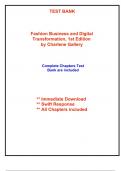TEST BANK
Fashion Business and Digital
Transformation, 1st Edition
by Charlene Gallery
Complete Chapters Test
Bank are included
** Immediate Download
** Swift Response
** All Chapters included
,Table of Contents are given below
Chapter 1.1 Introduction to Digital Transformation in the Fashion
Industry
Chapter 1.2 Digital Transformation Strategies: Unlocking Change
in Fashion
Chapter 2.1 Material Digitalisation for Digital Product Creation
Chapter 2.2 The Shift to Digital in Fashion Product Development
Chapter 2.3 Process Innovation in Fashion Manufacturing
Chapter 2.4 Merchandising Innovation: Digitalising the supply
chain and ethical sourcing
Chapter 3.1: Marketing to the Hyper-Connected Consumer
Chapter 3.2: Retail Innovation: The Future of the Physical Store
Chapter 3.3: Retail Innovation 2: The Future of Online Selling
Chapter 4.1: Digital Skills in Fashion
,Chapter 1: Learning resources
20 MCQ
1. Significant growth in online retail first occurred in
a. Before 1995
b. In 1999
c. In 2000s
d. In 2010s
2. PLM is an acronym for
a. Product Line Manager
b. Purchase Location Model
c. Product Lifecycle Management
d. Product Legal Media
e. Purchase Ledger Maintenance
3. The four core technologies abbreviated to SMAC are:
a. Smart, media, automation, and chatbot
b. Smart, mobile, augment, and computing
c. Social, mobile, analytics and cloud
d. Social media, m-commerce, automation, and computation.
4. The term “disruptive innovation” was first coined in:
a. The 1960s
b. The 1970s
c. The 1980s
d. The 1990s
e. The 2000s
5. The components of Fashion Industry 4.0 are:
a. smart processes, smart people, smart goals
b. smart devices, smart systems, smart networks
c. smart sensors, smart systems, smart applications
d. smart processes, smart devices, smart skills
e. smart products, smart factories, smart networks
6. Four of the six the principles of Fashion Industry 4.0 are:
a. interoperability, real time capabilities, modularity, and service orientation
b. information sharing, real time capabilities, virtualisation, and centralisation
c. interoperability, real time capabilities, visualisation, service orientation,
d. information sharing, visualisation, modularity, and centralisation
e. interoperability, customer-focussed, modularity, and decentralisation.
7. In product-centric merchandising
a. The process starts with the product and actual demand is achieved with push supply
chains.
b. The process starts with the product and actual demand is achieved with pull supply
chains.
c. The process starts with the product and actual demand is achieved with agile supply
chains.
d. The process starts with the product and actual demand is achieved with push supply
chains.
e. The process starts with the product and actual demand is achieved with agile supply
chains.
, 8. In consumer-centric merchandising
a. The process starts with the consumer and forecasted demand is achieved with pull
supply chains.
b. The process starts with the consumer and actual demand is achieved with push
supply chains.
c. The process starts with the product and actual demand is achieved with pull supply
chains.
d. The process starts with the consumer and forecasted demand is achieved with agile
supply chains.
e. The process starts with the consumer and actual demand is achieved with
responsive supply chains.
9. Overproduction was a consequence of
a. Fast fashion.
b. Off-shoring.
c. Consumer behaviour
d. Demand forecasting.
10. Omnichannel is a retail strategy that:
a. Seeks to engage customers consistently through multiple digital and physical
touchpoints.
b. Is an alternative name for multichannel retailing.
c. Uses all available digital platforms to maximise consumer engagement.
d. Uses digital technologies successfully in physical stores.
11. Industry 5.0 focuses on three interconnected core values of:
a. Cooperation, ESG, risk management
b. Biodiversity, human rights, risk management
c. Sustainability, human-centricity, and resilience
d. Transparency, anti-corruption, human rights
e. Transparency, resilience, fairness
12. The global second-hand fashion business model has changed rapidly from
a. $14 billion dollars in 2014 and is now forecasted to reach a value of $351 billion
dollars by 2027
b. $1 billion dollars in 2014 and is now forecasted to reach a value of $35 billion dollars
by 2027
c. $4 billion dollars in 2014 and is now forecasted to reach a value of $351 billion
dollars by 2037
d. $4 billion dollars in 2014 and is now forecasted to reach a value of $451 billion
dollars by 2027
13. Productivity is
a. Increasing due to adoption of technology.
b. A key performance indicator (KPI) that is used by accountants.
c. An important measure of performance and efficiency.
d. A proxy for a company’s profitability and competitiveness
14. Some of the benefits of cloud computing for businesses include:
a. increased flexibility, scalability, security and affordability.
b. increased flexibility, affordability, scalability, and reduced costs.
c. increased flexibility, affordability, scalability, and processing power.
d. increased adaptability, scalability, security and affordability.
15. ESG is an abbreviation for:




